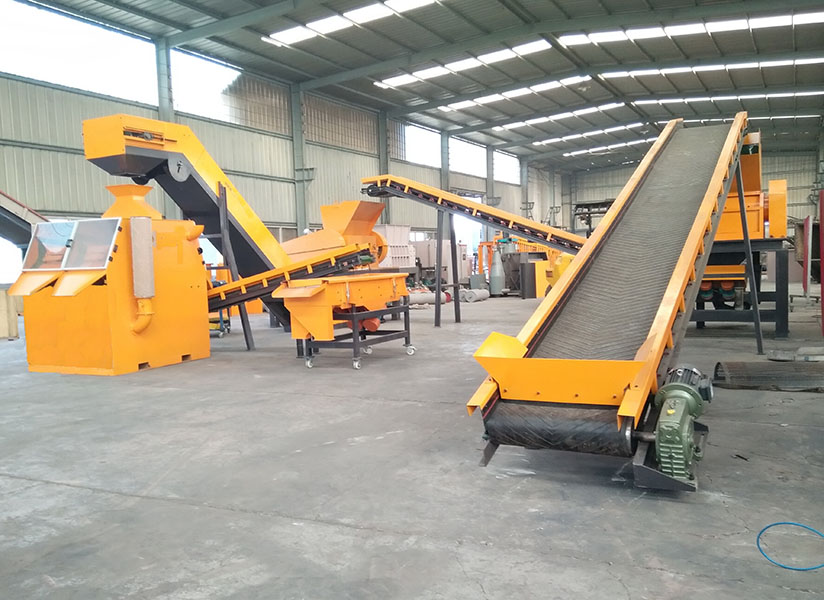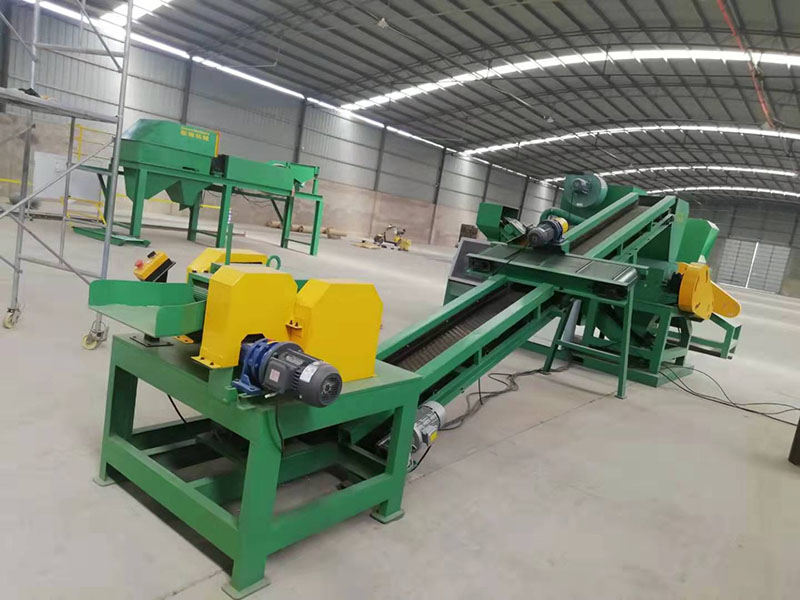
Sep . 15, 2025 09:40 Back to list
The global demand for efficient metal recycling solutions continues to surge, driven by resource scarcity, environmental regulations, and the economic benefits of reclaiming valuable materials. In particular, the recycling of copper, a critical industrial metal, plays a pivotal role in sustainable manufacturing. The market for copper recycling is projected to grow at a compound annual growth rate (CAGR) of over 4.5% from 2023 to 2030, reaching an estimated value of USD 40 billion. This expansion is fueled by the escalating generation of electrical and electronic waste (e-waste), which is rich in copper content, and the increasing adoption of circular economy principles across industries.
Within this context, the Copper wire granulator stands out as a fundamental technology. These sophisticated machines are engineered to efficiently process discarded copper cables and wires, separating the copper from its insulation (PVC, rubber, etc.) through mechanical means, thus providing high-purity copper granules ready for reuse. The environmental imperative to reduce landfill waste and conserve primary copper resources, coupled with the economic incentive of high-value recycled copper, makes these granulators indispensable assets in the modern recycling landscape. Innovations in granulator design, focusing on higher separation rates, lower energy consumption, and increased automation, are continually enhancing their operational efficiency and broader market appeal.
The operation of a Copper wire granulator system is a multi-stage mechanical process designed for the dry separation of copper from insulating materials. This method ensures minimal environmental impact compared to traditional smelting processes and yields high-ppurity copper granules.
The manufacturing processes for these components involve precision engineering. Blades undergo vacuum heat treatment to achieve optimal hardness and toughness. Frame components are often forged for maximum strength and then precision-machined. Each granulator undergoes rigorous quality testing, including material composition analysis, dimensional accuracy checks, and operational performance tests under load, conforming to ISO 9001 quality management principles. The typical service life of a well-maintained Copper wire granulator exceeds 15 years, thanks to robust construction and replaceable wear parts.

Understanding the technical parameters of a Copper wire granulator is crucial for assessing its suitability for specific recycling operations. These machines are designed for high throughput, energy efficiency, and reliable separation performance across various cable types.

These specifications underscore the advanced engineering involved, ensuring not only high-grade output but also operational safety and environmental compliance. The selection of materials like Cr12MoV for granulator blades is a testament to the focus on durability and reduced maintenance cycles, critical for high-volume industrial applications.
The versatility and efficiency of a Copper wire granulator make it an indispensable asset across a broad spectrum of industries dealing with copper waste streams. These systems are engineered to handle various types of insulated copper wires, from fine communications cables to heavy-duty power lines.
In typical application scenarios, the advantages of using a modern Copper wire granulator are manifold. For example, in a large-scale e-waste processing facility, the granulator significantly reduces manual labor costs associated with stripping wires, increasing processing speed by over 500%. Furthermore, its dry separation method ensures no hazardous waste water discharge, aligning with stringent environmental regulations and contributing to a cleaner operational footprint. The high purity of the separated copper also commands a premium in the market, enhancing profitability for recycling operations.
Modern Copper wire granulator systems incorporate several design and functional advantages that contribute to their superior performance, economic viability, and environmental responsibility.

These technical advantages translate directly into significant return on investment (ROI) for recycling businesses, through higher yields, lower operational expenses, and compliance with stringent environmental regulations.
Selecting the right Copper wire granulator involves a critical comparison of various vendors based on key performance indicators, technological sophistication, and support services. While specific vendor names are not provided here, a generalized comparison highlights crucial differentiators.
When evaluating vendors, it is crucial to consider not only the initial capital expenditure but also the total cost of ownership (TCO), which includes energy consumption, maintenance, wear parts, and labor. A premium Copper wire granulator system, while potentially having a higher upfront cost, often provides a significantly better ROI through superior output purity, lower operational expenses, and extended equipment longevity.

Recognizing that recycling needs vary widely, leading manufacturers offer highly customized Copper wire granulator solutions. These adaptations ensure optimal performance for specific material types, throughput requirements, and spatial constraints.
A prominent European e-waste recycling firm, facing increasing volumes of mixed household and industrial wiring, deployed a custom-designed OWR-1000 Copper wire granulator system with an integrated pre-shredder and electrostatic separator. This customized solution, featuring a processing capacity of 1000 kg/hour, allowed the client to achieve consistent copper purity of 99.8% from highly contaminated input streams. The facility reported a 30% reduction in operational labor and a 15% increase in overall copper recovery rates within the first year of operation, demonstrating significant improvements in efficiency and profitability. This granulator handled materials ranging from fine network cables to medium power cords, ensuring minimal material loss.
Case Study 2: Automotive Parts Manufacturer In-house RecyclingAn automotive wiring harness manufacturer sought to minimize waste and reclaim valuable copper from their production off-cuts. A compact OWR-300 granulator was installed directly within their production facility. This smaller footprint system, optimized for processing clean, consistent copper wiring with PVC insulation, enabled the manufacturer to recycle 100% of their copper wire waste in-house. This eliminated waste disposal costs entirely and provided a steady supply of high-purity copper granules for direct resale to local foundries, achieving a return on investment within 18 months. Customer feedback highlighted the system's ease of operation and low noise profile, crucial for an indoor factory environment.

A: Our granulators can process various types of insulated copper wires, including household wires, communication cables, automotive wiring harnesses, and industrial power cables. Minimum wire diameter starts from 0.2mm.
A: With our advanced air-gravity and optional electrostatic separation, our systems typically achieve a copper purity of 99.5% to 99.9%.
A: Yes, our Copper wire granulator systems employ a dry separation process, eliminating the need for water and chemical treatments. Integrated dust collection systems ensure minimal air pollution, complying with ISO 14001 standards.
A: The primary wear parts are the granulator blades and screens. Blades, made from high-chromium tool steel, typically last 500-1500 operating hours depending on the material processed. Screens have a similar lifespan. Both are designed for quick replacement.
Standard Copper wire granulator models typically have a lead time of 6-8 weeks from order confirmation to shipment. Customized systems may require 10-14 weeks, depending on the complexity of modifications and component sourcing. We maintain a robust supply chain and efficient manufacturing processes to ensure timely delivery. Detailed fulfillment schedules, including factory acceptance testing (FAT) and logistics planning, are provided at the time of order.
All our Copper wire granulator systems come with a comprehensive 12-month warranty on non-wearable parts, starting from the date of commissioning or 18 months from shipment, whichever comes first. This warranty covers manufacturing defects and component failures under normal operating conditions. Extended warranty options are available upon request.
We provide unparalleled customer support designed to ensure continuous, efficient operation of your recycling system. Our support includes:
Our commitment to customer satisfaction extends beyond the sale, fostering long-term partnerships built on reliability and performance.
Latest news
Trusted Double Shaft Shredder Supplier | Durable Industrial & Recycling Solutions
NewsNov.24,2025
Double Shaft Shredder Price Explained: Global Trends, Benefits & Vendor Comparisons
NewsNov.24,2025
Expert Insights into Double Shaft Shredder Factory: Boosting Global Recycling Efficiency
NewsNov.23,2025
Leading Double Shaft Shredder Suppliers for Industrial Recycling and Waste Management
NewsNov.23,2025
Leading Double Shaft Shredder Manufacturers | Durable & Sustainable Industrial Shredders
NewsNov.23,2025
Understanding Double Shaft Shredder Machine Price: Buyers’ Guide & Global Insights
NewsNov.22,2025